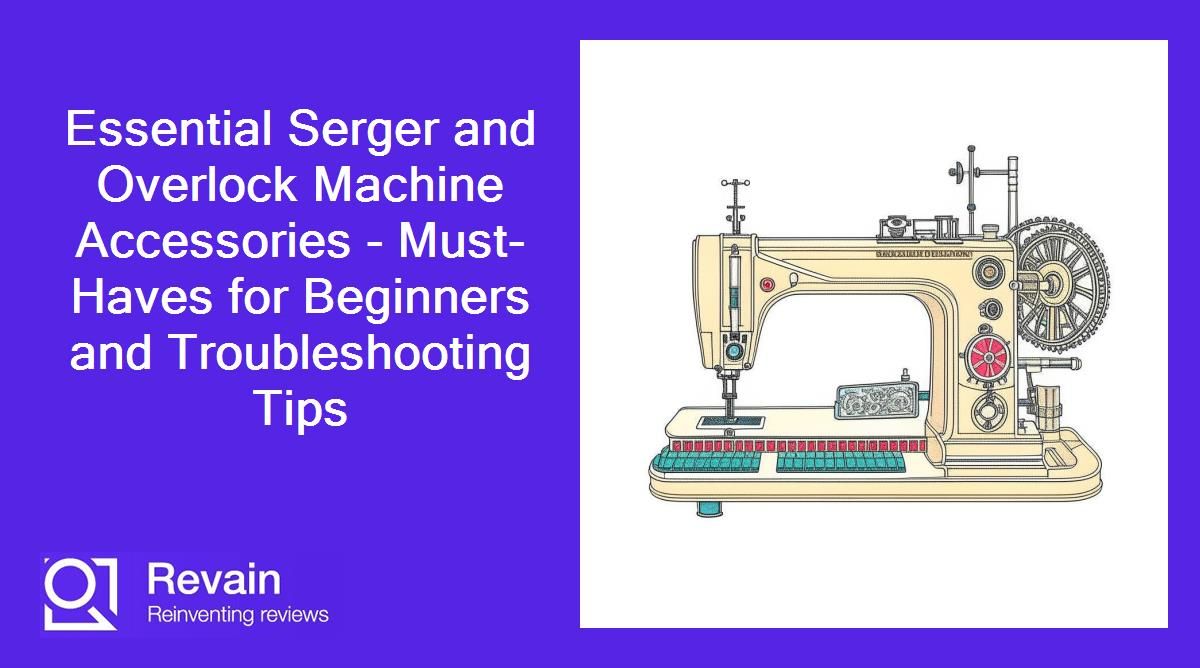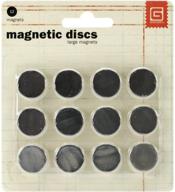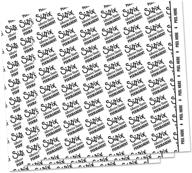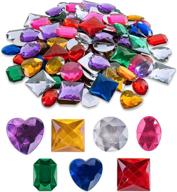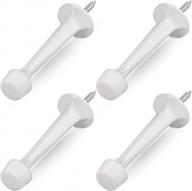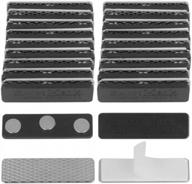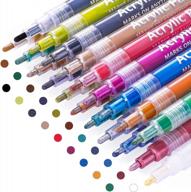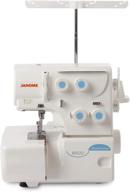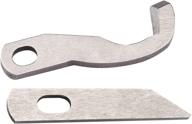Essential Serger Accessories for Beginners
Getting started with a serger can be intimidating for beginner sewers. While the serger machine itself is essential, there are many serger accessories that can make your projects easier and help you get the most out of your machine. Here are some must-have accessories for serger beginners.
Needles
Sergers use specialized needles that are different from regular sewing machine needles. Using the correct needle for your fabric type and thread is key to preventing skipped stitches and thread breaks. Have a variety of serger needles on hand in sizes 11/75, 14/90, and 16/100 for lightweight, medium weight, and heavy weight fabrics respectively.
Thread
- All purpose serger thread - Stock up on high quality all purpose serger thread in a range of colors for sewing and construction seams.
- Woolly nylon thread - Used in the upper looper, woolly nylon thread creates stretchy and durable seams for knits. Have black and white woolly nylon thread handy.
- Decorative thread - Add decorative threads like metallics, pearlescent, and heavy weight to the upper looper for embellishing projects.
Another interesting products
Seam Ripper
A tiny seam ripper is indispensible for removing stitches to fix sewing mistakes. The curved tip allows you to get into corners easily.
Top products in 🔧 Serger & Overlock Machine Accessories
Tweezers
Slender tweezers help when dealing with the tiny spaces in the serger and are great for guiding threads through guides and tension discs. Get a pair with a sharp, fine tip.
Similar products
Lint Brush
Lint and stray threads can build up in the serger and need to be cleaned out regularly. A soft bristle lint brush is the perfect tool for brushing away lint in hard to reach areas.
Scissors
Have a dedicated pair of sharp scissors for serger use only. Scissors are essential for cutting thread chains or threads at the end of seams.
With this starter set of needles, specialty threads, and tools, serger beginners will have all the accessories they need to start creating beautiful finished seams and edges. Investing in these serger essentials will make projects go smoother and help enhance your skills.
Get the Most Out of Your Overlocker
Overlock machines, also known as sergers, are invaluable tools for achieving professional-looking finished seams and hems in your sewing projects. With the right accessories and tips, you can optimize your overlocker to get the most out of it.
Feet
Using specialty presser feet opens up many possibilities and techniques:
- Rolled hem foot - Create narrow rolled edges on lightweight fabrics like napkins and handkerchiefs.
- Piping foot - Insert piping easily for a tailored finish on pillows, cushions and more.
- Elastic foot - Attach elastic perfectly for shirring, waistbands and elastic edging.
Needles
Always use the recommended needles for your fabric type. Ball point needles glide smoothly on knits. Sharp needles are best for woven fabrics. Have a range of sizes like 11/75, 14/90 and 16/100 on hand.
Thread
Quality thread prevents breaks and slipping stitches. Use all purpose for construction, woolly nylon for stretch fabrics, heavy weight for decoration, and metallics or silk for embellishment.
Tools
- Seam ripper - Fix mistakes quickly by ripping seams.
- Tweezers - Maneuver thread into the serger's tight spots.
- Lint brush - Remove lint for optimal performance.
Storage
Have a dedicated serger tote to store all your accessories, spare needles, thread cones, spare blades and manuals.
Maintenance
- Change the needle regularly.
- Clean lint and old threads often.
- Oil as recommended by manual.
- Replace lower blade annually.
With the right accessories and care, your overlocker can handle all types of projects from sheer silks to chunky knits. Follow these tips to empower your serger skills and get the most out of this versatile sewing machine.
Serger Troubleshooting Made Simple
Sergers are hemming heroes that can whip up professional-looking seams and edges in no time. However, when things go awry, troubleshooting serger problems can feel daunting. With a few simple fixes, you can get your serger back on track in no time.
Thread Breaks
- Replace needle if bent or blunt.
- Rethread completely ensuring correct threading order.
- Increase upper looper thread tension if lower looper thread is breaking.
- Use high quality serger thread appropriate for fabric.
Skipped Stitches
- Insert new sharp needle properly and fully.
- Increase thread tension slightly.
- Check threading path - reroute any threads not following guides.
- Change to correct size needle for fabric.
Fabric Rolling or Puckering
- Loosen upper looper thread tension.
- Use lightweight, woven stabilizer with very lightweight fabrics.
- Check for damaged or dull blades.
- Adjust presser foot pressure to lighter setting.
Loose Stitches
- Rethread ensuring threads are under all guides and through tensions.
- Increase tension on loose thread(s).
- Check needles are inserted fully and correctly.
- Change needle to smaller size if too large for fabric.
Irregular Stitches
- Clean under needle plate and feed dogs.
- Use presser foot pressure appropriate for fabric.
- Insert new sharp needle properly.
- Adjust tension carefully following manual guidelines.
Don't let serger issues slow you down. Run through this troubleshooting checklist and you'll have your serger stitching perfectly in no time.
Skipped Stitches
Finding skipped stitches in your serger seams can be frustrating. This common issue makes seams look unfinished and can even cause them to unravel. Luckily, skipped stitches can often be fixed with a few easy troubleshooting steps.
Check Needle Condition
One of the most common causes of skipped serger stitches is a damaged needle. The needle may be bent, blunt, or not fully inserted. Always start by replacing the needle with a new one appropriate for your fabric weight and thread size.
- Use size 11/75 needles for lightweight fabrics
- Size 14/90 for medium weight fabrics
- Size 16/100 for heavy fabrics
Be sure the needle is pushed up firmly and completely into the needle clamp, with the flat side facing back.
Thread Tension
Incorrect thread tension can also cause skipped stitches. If the tension is too loose, the thread loops are not forming correctly to create stitches.
- Slightly tighten tensions, one at a time, to find problem thread.
- Upper looper usually needs more tension than lower looper.
- Use tension settings recommended for your fabric type.
Thread Path
It's crucial for threads to be threaded properly through every guide and tension disc. If threads are not following the correct path, the loop formation can be disrupted, leading to skipped stitches.
- Rethread completely, double checking route.
- Use threading chart in manual if unsure of path.
- Thread needles last after loopers are threaded.
Insert Needle Properly
A needle that is not fully and correctly inserted can cause skipped stitches. Double check that:
- Needle is pushed up as far as possible
- Flat side of needle shaft faces back
- Needle scarf is toward front
With some simple needle troubleshooting, thread tension and path adjustments, you can banish skipped stitches from your serged seams for good.
What is the benefit of Amazon Prime when buying "Serger & Overlock Machine Accessories"?
As any avid sewer knows, having the right accessories for your serger or overlock machine is crucial for achieving professional results on your projects. When purchasing serger accessories like specialty needles, threads, feet and tools, Amazon Prime provides some major benefits:
Free Two-Day Shipping
One of the best perks of Amazon Prime is free two-day shipping on millions of eligible items. This means no more waiting over a week to get your supplies. Any serger needles, presser feet, tools or notions that show "Prime Eligible" can be at your door in just two days when you need them.
Free One-Day and Same-Day Delivery
For those times when you need something urgently, like realizing at 10pm the night before a project is due that you're missing a certain serger foot, Amazon offers free one-day and same-day delivery on qualifying orders over $35. Prime members in eligible areas can get accessories rushed to their door in time for next-day projects.
Free Returns
Buying specialty sewing items like serger accessories online can feel risky, but Amazon Prime members enjoy free, convenient returns. If a certain needle or foot doesn't end up working for your machine or project, send it back for free. Trying new serger accessories becomes easy and risk-free.
Amazon Prime Wardrobe
For large accessories like serger tables or covers, Prime members can use Amazon's Prime Wardrobe feature to try items for 7 days before fully committing. This makes purchasing bulky accessories that are hard to return hassle-free.
Lightning Deals
As a Prime member, you have access to special Lightning deals offering big discounts on select items for just a few hours. It's worth checking regularly for serger accessories like thread kits, needles and feet to score for less.
With these Prime benefits, sewing enthusiasts can conveniently build their serger accessory arsenal from the comfort of home. Never run out of needles or wait weeks for delivery again!
What Are The Most Popular Serger And Overlock Machine Accessories?
Based on the search results, here are some of the most popular serger and overlock machine accessories:
- Overlocker presser feet: These accessories make overlocker sewing easier and help your creativity soar.
- Supporting overlock accessory: This accessory can help you achieve professional results.
- Serger thread cones: These are a must-have accessory for any serger machine.
- Serger needles: These are also a must-have accessory for any serger machine.
- Serger tweezers: These are useful for threading needles and removing stitches.
- Serger dust cover: This accessory is lightweight, easy to clean, and fits most portable or cabinet serger machines.
Note that there are many other serger and overlock machine accessories available, and the popularity of these accessories may vary depending on the user's needs and preferences.
What Are The Differences Between Serger And Overlock Machine Accessories?
Based on the search results, here are some differences between serger and overlock machine accessories:
Note that the differences between serger and overlock machine accessories may vary depending on the user's needs and preferences.
What Are The Most Common Types Of Serger And Overlock Machine Accessories?
Based on the search results, here are some of the most common types of serger and overlock machine accessories:
Note that there are many other serger and overlock machine accessories available, and the most common types of accessories may vary depending on the user's needs and preferences.






